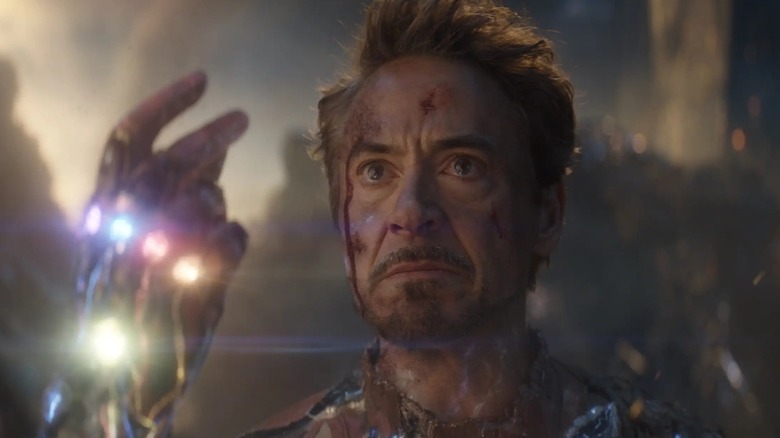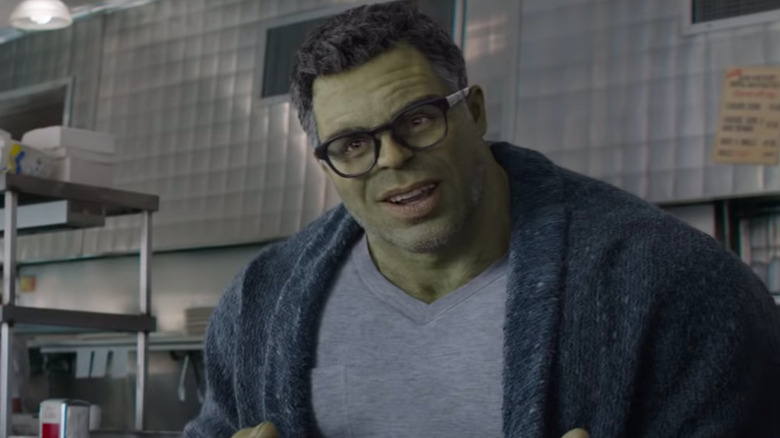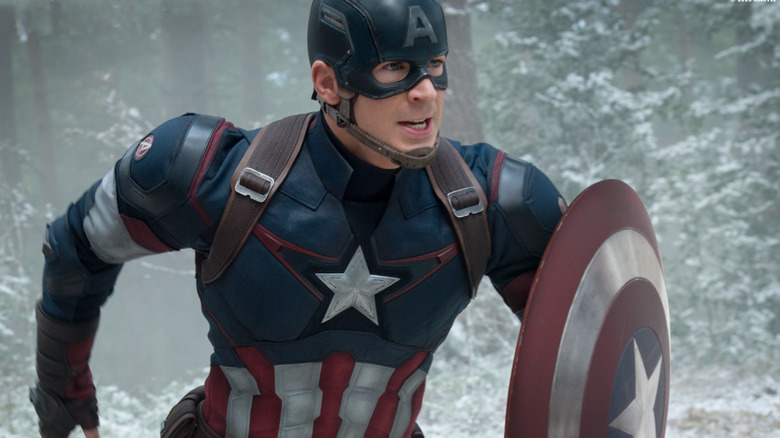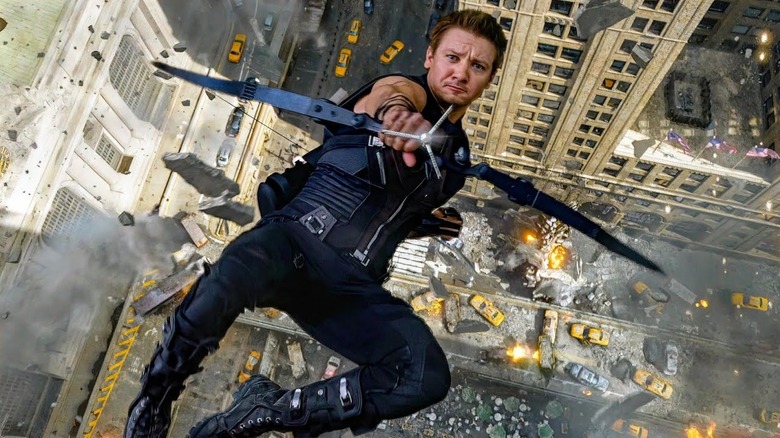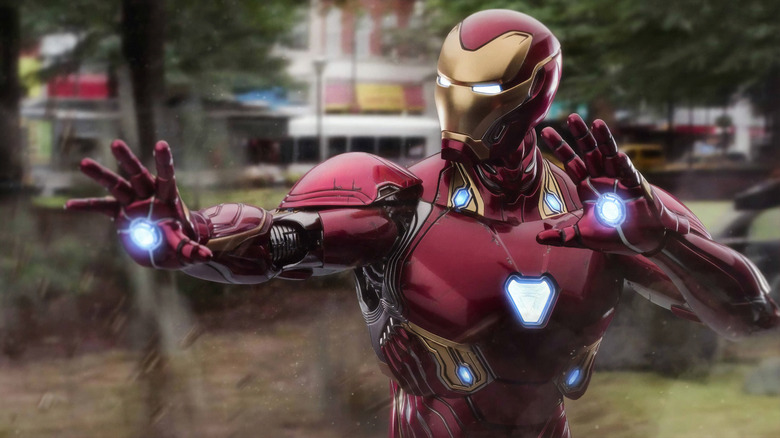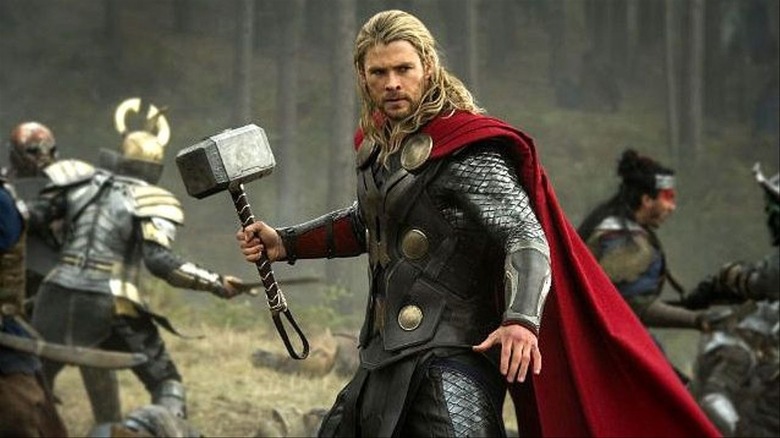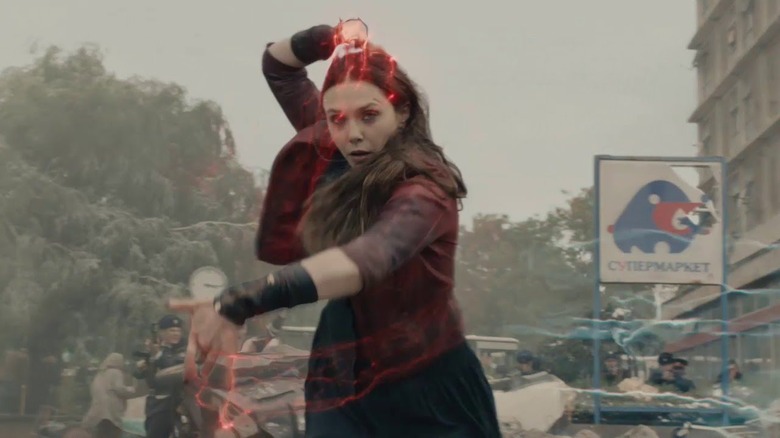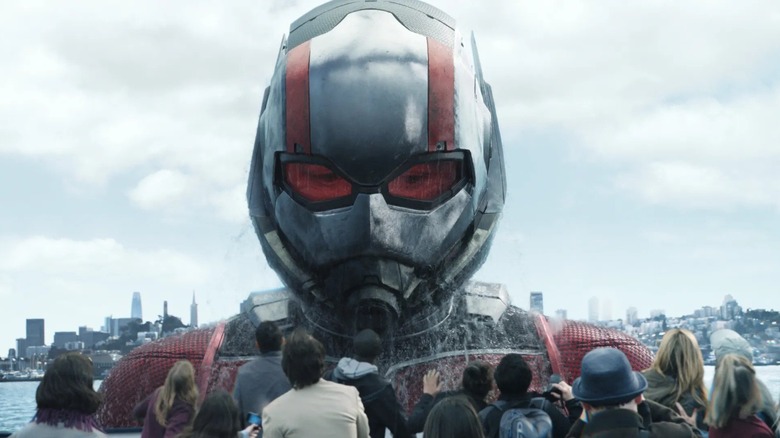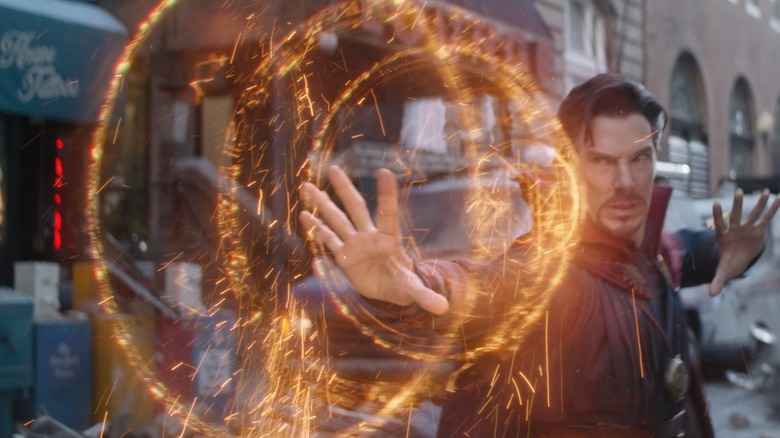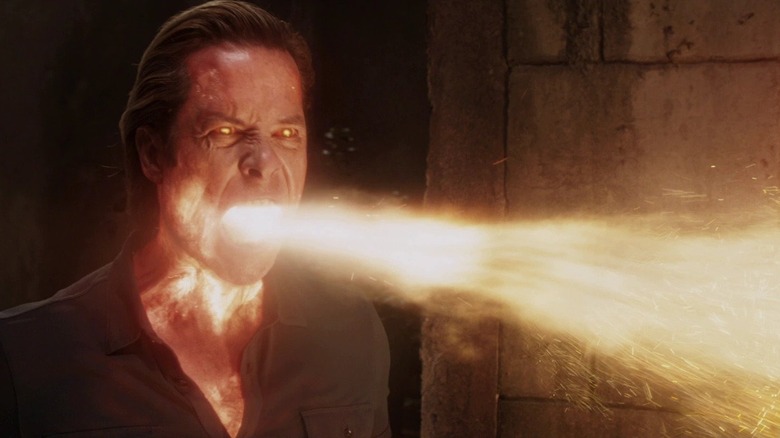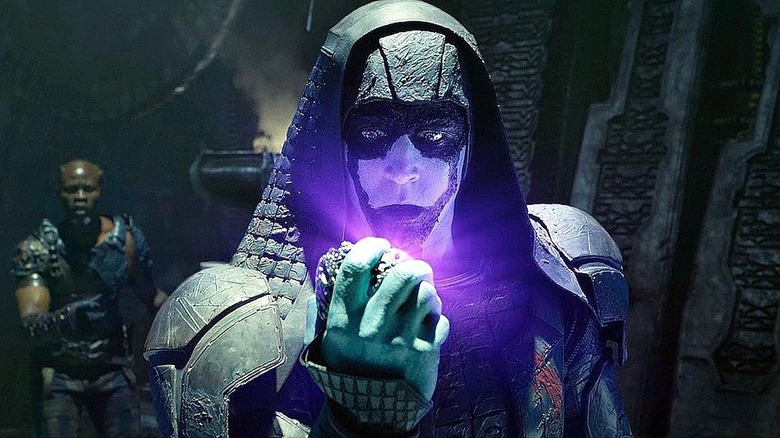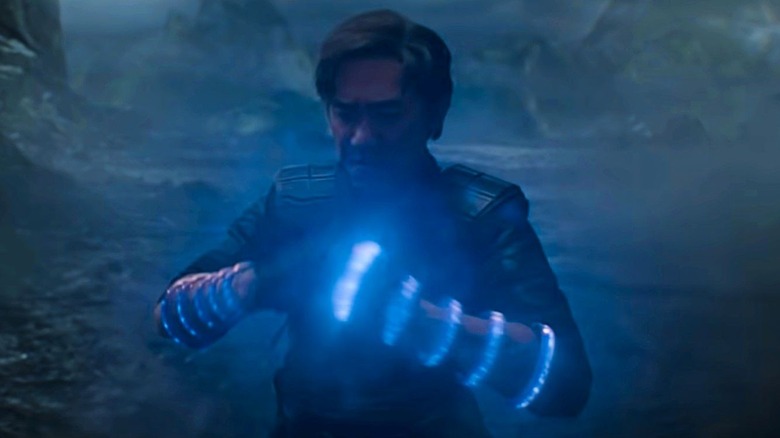MCU Superpowers That Don't Quite Make Sense
One of the best things about the Marvel Cinematic Universe is seeing countless beloved characters from the comics up on the big screen with their superpowers so wonderfully depicted. Ever since "Iron Man" hit theaters in 2008, Kevin Feige and co. have spared no expense in ensuring that these characters are as accurately portrayed as possible, using only the most cutting-edge visual effects wizardry to bring these superhuman and often otherworldly powers to life. From the Hulk's massive green strength to Thanos' otherworldly might to Scarlet Witch's eldritch magic, Marvel Comics fans have, well, marveled at seeing their favorite characters so stunningly realized.
However, as fun as it is to see this pantheon of heroes and villains' abilities given big budget respect, sometimes their powers don't really add up. We're not trying to nitpick, as we fully acknowledge that these are fantastical films and that overexplaining anything can ruin the fun. Also, because of the long-running nature of comic books, there's more breathing room for them to go into more detail about how a superpower works than there is in a typical two-hour movie. That still doesn't excuse the fact that some of the superpowers in the Marvel Cinematic Universe defy logic, even in a colorful fictional world filled with aliens, alternate dimensions, and magical beings. Let's take a look at some of the MCU superpowers that don't quite make sense.
The Hulk's Transformations
Bruce Banner/Hulk has been around in the Marvel Cinematic Universe since its earliest days (2008's "The Incredible Hulk" was the second movie released in the MCU) and as such his powers have taken on different variations over the years. As a scientist, Banner was trying to recreate the Super Soldier Serum that produced Captain America, but with gamma radiation this time. While Banner did succeed in increasing his strength, stamina, and durability, it also increased his size and turned his skin green. He could only turn into his "hulk" form when he's angry, meaning Banner has to keep himself calm at all times or he'll turn into a massive, uncontrollable monster.
While Banner spends much of his early appearances in the MCU trying to keep the big green guy suppressed by not getting angry, he sometimes broke this self-imposed rule. For example, during the Chitauri invasion in "The Avengers" Captain America asks Banner to get angry, to which Banner reveals that he's always angry. If this were true, wouldn't he always be the Hulk? This was the case, however, in "Thor: Ragnarok" where he spent most of his time on Sakaar as the Hulk. Banner managed to fuse the two parts of himself in "Avengers: Endgame" so that he could have both brains and brawn simultaneously, but the mid-credits scene of "Shang-Chi and the Legend of the Ten Rings" sees him back in his regular human form. Make up your mind, Banner!
Captain America's Shield-Wielding
Captain America's shield is one of the most iconic weapons in the MCU and has been put to brilliant use across film and TV. It was first built by Howard Stark (Tony Stark's father) out of vibranium and claimed that it was "stronger than steel and a third of the weight. It's completely vibration absorbent." After helping Cap take down the Red Skull and Hydra's forces during WWII, the shield spent several decades frozen in ice in the ocean before returning to battle with Cap in his tenure with the Avengers and S.H.I.E.L.D., enduring all kinds of damage before ultimately getting shattered by Thanos' double-edged sword in "Avengers: Endgame."
Can we overlook the fact that a serum developed eighty years ago was able to turn a 98-pound weakling into hunky Chris Evans? Absolutely. What about a shield that's made out of a fictional metal and can only be damaged by an alien helicopter blade? Yup. The thing that stretches logic is the shield's boomerang capabilities that manifest whenever anyone uses it. No matter who throws it, it always returns to its owner, something that can't be ascribed to the Super Soldier serum coursing through Cap's veins or vibranium. "The Falcon and the Winter Soldier" at least had the decency to show Sam Wilson in a training montage with the shield, but that still doesn't explain how even a regular person can throw and catch it with perfect accuracy every time.
Hawkeye's Archery Skills
While archery isn't exactly a superpower (at least when put up next to someone who can fly and shoot laser beams in a red suit or turn into a giant jade behemoth with superhuman strength), Hawkeye has proven to be an invaluable member of the Avengers many times. With a command of the quiver that would put any Olympic-level archer to shame and an arrow for pretty much any situation, Hawkeye has more than pulled his weight with Earth's Mightiest Heroes, whether it's going up against a Chitauri invasion, an army of Ultron bots, or even his fellow heroes.
It's tempting to make Robin Hood and Katniss Everdeen jokes here, but we won't reach for that low-hanging fruit. No, we're going to focus on Hawkeye's seeming sixth sense when it comes to hitting targets with a weapon that cavemen used. It's one thing to have a character who's just really REALLY good at archery, but it's another that said character can take out a Chitauri soldier flying behind him — without even looking! — like Hawkeye did in "The Avengers." Don't even get us started on the arrows: Does Hawkeye really sit down before every battle and make sure he has an arrow for every scenario? "This is a grappling arrow in case I get thrown off a 37-story building in New York City. This arrow can melt alien metal. Oh, and this one can explode into a bunch of smaller arrows for when I fight Iron Man."
Iron Man's Armor
Tony Stark's superpower is that he is unbelievably smart as both a businessman and an engineer, which has led to him building Iron Man armor that's essentially what would result if Elon Musk got into the fashion industry. From the bulky yet effective Mark I that he built with Ho Yinsen while in captivity to the futuristic nanotech Mark LXXXV suit, each film appearance of Iron Man has revealed a new suit that improved on the version before it. Some of the armor features include energy blast projection, flight, increased strength/durability, and so much more.
Every suit that Tony Stark has built pushed the boundaries of what's actually mechanically or scientifically possible and, in many ways, that's part of what has made him such a fun character to watch. However, the nanotech armors introduced in "Avengers: Infinity War" and "Avengers: Endgame" were basically magic. During the fight with Ebony Maw and Cull Obsidian in New York City, Tony pulls a couple of strings on his jacket and the armor instantly builds itself around him, meaning he's carrying many pounds of metal and circuitry on his person at all times. These armors also allow Iron Man to conjure up an arsenal of features and weapons, like foot thrusters, shields, blades, and more. Nanite manipulation is certainly a useful ability, but creating matter from nowhere is sort of crossing over into unbelievable territory.
Thor's Hammer-Wielding
Thor's hammer Mjolnir is another iconic weapon in the MCU that had a tumultuous journey in both films and comics. Forged in the heart of a star, Thor lost his ability to wield it when his father no longer considered him "worthy," banishing him to Earth to live as a mortal until he learned humility. Thor would eventually prove himself and reclaim Mjolnir, going on countless battles with it on his own and with the Avengers. In fact, it was Vision's ability to wield Mjolnir that proved to the team that he could be trusted with the Mind Stone embedded in his head. Mjolnir was destroyed by Hela in "Thor: Ragnarok," but Thor upgraded to Stormbreaker in "Avengers: Infinity War."
We'll go a little easier when it comes to scrutinizing Thor's hammer-wielding powers, as he and his weapons have magical origins. However, there are still a few little things that bug us about the ability. For example, we'll accept the idea that a hammer can be used as a conduit for his command of lightning, but how come it has the ability to dress him in his Asgardian battle armor, such as when he proved his worthiness in the first "Thor" movie or just before the final battle against Thanos in "Avengers: Endgame?" Also, remember when it was established that Thor could only travel across the Nine Realms with the help of the Bifrost, only for Thor to zip across the galaxy with nothing but Mjolnir?
Wanda's Abilities
Wanda Maximoff (eventually the Scarlet Witch) has gradually grown into one of the most complex and powerful characters in the Marvel Cinematic Universe ever since her first appearance in the post-credits scene for "Captain America: The Winter Soldier." Initially, her power set largely consisted of mental abilities, including perception manipulation and telekinesis. In "Avengers: Age of Ultron," Wanda is able to warp the minds of several Avengers by making them live out some of their worst fears, and later takes out whole swaths of Ultron clones with the power of her mind alone. As command over her powers increased, so did her ability to go toe-to-toe with bigger threats like the Black Order and Thanos himself.
"WandaVision" explores her powers even further when it's revealed that she was born with latent chaos magic and that the experiments with Loki's scepter simply unlocked them. It's not a bad explanation as far as superhero origin stories go, but it does a lot of heavy lifting in excusing her massive power surge in recent movies and TV shows. Reality-warping and multiverse-hopping put Wanda closer to a god than a mere superhero, stretching the logic of how her powers work almost to the breaking point. Sure, she got some help from her study of the Darkhold, but by the time of "Doctor Strange in the Multiverse of Madness," it seems that there's not much she can't do, far exceeding the abilities she gained as a human test subject.
Ant-Man's Abilities
The ability to shrink down to the size of an insect and influence the minds of ants to do one's bidding doesn't exactly scream "world-saving potential." However, Scott Lang has thwarted plenty of villains as the Ant-Man using Hank Pym's patented Pym Particles and specially made size-changing suit. When Ant-Man shrinks, the space between the atoms that comprise his body also shrinks, thereby increasing his density so that he retains the strength of his full-sized self. Or, as Hope van Dyne described it: "When you're small, energy's compressed, so you have the force of a 200-pound man behind a fist a 100th of an inch wide. You're like a bullet."
While the physics behind that description could probably be nitpicked to death by actual physicists, it's reasonable enough to accept in a movie called "Ant-Man" so we'll let it slide. However, there's another ability that Ant-Man has that actually creates some gaps in logic, which is that of enlarging himself. We first saw Ant-Man become his Giant-Man persona from the comics in "Captain America: Civil War." The problem this ability poses is that it deviates from the physics that guide his shrinking power; if decreasing in size increases his density, shouldn't increasing his size decrease his density? Yet in every instance we've seen him grow to enormous heights, his strength and density increase at a commensurate rate. Give Hank Pym some Pulitzer Prizes for the discovery of creating matter from nothing.
Doctor Strange's Magical Powers
Being a Master of the Mystic Arts means there are a whole plethora of powers one can tap into. One of the go-to powers that Doctor Strange relies on is that of shield conjuring, which he uses to block the blows of his opponents and protect himself from debris. His Cloak of Levitation allows him to ... levitate, and also seems to have some sort of sentience for getting Strange out of trouble even when he's incapacitated. The 2016 "Doctor Strange" sees the hero manipulating the flow of time with the help of the Eye of Agamotto, as well as opening and closing portals that access other dimensions like in "Spider-Man: No Way Home" and "Doctor Strange in the Multiverse of Madness."
The abilities previously listed don't even scratch the surface of the wide number of spells Doctor Strange has at his disposal. While there's no sense in questioning the magical origins of Strange's powers, we are going to question the inconsistency of the application of his powers, which seems to come down to what the script needs him to do. In "Doctor Strange," he's warned not to play with time by Wong as it could seriously upset the laws of nature, only to be later encouraged by Wong to turn back time to reverse the damage done by Kaecilius. There's an eldritch set of rules that govern what Strange can and can't do, but they seem to only exist to complicate things for him.
Extremis' Abilities
"Iron Man 3" got most of its inspiration from the "Extremis" storyline, one of the best Iron Man comics ever. The film focuses on the Extremis formula developed by Maya Hansen and Aldrich Killian which was initially created to help human subjects heal and regenerate physical and psychological wounds. The formula proved to be extremely unpredictable, helping some to regrow entire limbs or gain increased abilities while causing others to combust and die. After several positive results with disabled veterans, Killian planned to use the enhanced subjects as personal soldiers, with the full backing of Advanced Idea Mechanics. Killian's plans are thwarted by Iron Man and an Extremis-powered Pepper Potts.
The effects Extremis has on people are all over the place and seem to only get more complicated as the film goes on. At first, it's presented as a treatment for those with advanced bodily or neurological damage to help them regenerate and become whole again. It's a bit outré but believable enough in the context of a superhero movie. It's also revealed that Extremis can bestow its subjects with increased strength, durability, and speed, functioning as a sort of Super Soldier serum. Still pushing the boundaries of believability, but we'll buy it. The addition of fire breath, though, is a tad overkill, not to mention the fiery deaths it causes in random folks who take it. If spontaneous combustion is a possible side effect of any treatment, check with a doctor who doesn't work for AIM.
Ronan the Accuser's Power Stone-Wielding
Ronan the Accuser is the primary antagonist of "Guardians of the Galaxy." A vengeful Kree militant, Ronan felt betrayed by the treaty established between his people and the Xandarians, so he set out to exact revenge against Xandar. As part of his efforts to exterminate the Nova Empire, Ronan made a deal with the Mad Titan Thanos: If Ronan acquires a mysterious orb for Thanos, he'll supply him with support in his war against Xandar. However, when Ronan discovered that the mysterious orb contained the Power Stone, he backed out of the deal to keep the Stone for himself, declaring Thanos an enemy.
It makes perfect sense that the Power Stone would be so powerful that anyone who simply holds it in their hands would disintegrate. This is exactly what happens to Carina, a slave of the Collector on Knowhere when she grabs the Power Stone to free herself. It took the collective might of all of the Guardians to wield the Power Stone to kill Ronan, and even they endured some damage (and let's not forget that Peter Quill has some Celestial DNA in him!). So what makes Ronan so special that he could grab the Power Stone and ram it into his hammer without a scratch? He may have some enhanced strength and stamina on account of being an alien, but there should have been a little more explanation for why he could hold the Power Stone without turning into space dust.
The Ten Rings
The Ten Rings are a set of mystical metal rings that imbue their owner with a wealth of superhuman powers. They were discovered by Xu Wenwu thousands of years ago and allowed him to live indefinitely, using their powers to amass a great army and conquer his enemies. After meeting and falling in love with Ying Li in Tao Lo, Wenwu put his warring days to rest to start a family, giving up the Ten Rings and the powers they granted him. Of course, when a rival organization, the Iron Gang, had Li killed, Wenwu picked up the Ten Rings once more and declared war on those who murdered his wife.
In Marvel Comics lore, each of the Ten Rings has a special power, as seen here. While the basic idea of the rings giving their owner superhuman powers was kept for the movie, there is nowhere near the same amount of explanation given to the rings. While we can't fault the movie for not explaining each and every ability contained within the rings, we can deduct points for not putting any sort of limit on their capabilities. It just seems like everyone who wears them is given godlike powers, including greatly increased strength, speed, immortality, energy projection, and so so SO much more. The Ten Rings also seem to have some sort of consciousness as they always return to their current owner whenever they're thrown as projectiles or used as a whip.
Vision's Abilities
Vision was created when Ultron tried to make a superior version of himself using the Regeneration Cradle developed by Doctor Helen Cho along with the Mind Stone contained in Loki's scepter. However, the Avengers manage to steal the cradle before Ultron could upload his consciousness into it, and when they discovered that JARVIS existed inside of it, they activated the form with the help of Thor's lightning and thus Vision was born. Since then, he became an invaluable member of the team helping them to defeat Ultron and fend off Thanos' Black Order. While Vision was killed by Thanos and the Mind Stone removed from his head, Vision was ultimately resurrected as White Vision through Scarlet Witch's chaos magic.
Vision came into this world equipped with all kinds of superpowers, most of which we're fine with accepting without question. Flight, laser beam projection, density manipulation, enhanced strength ... all of these powers make for fun fight scenes, so there's no reason to look too deeply into these abilities. However, we can't help but wonder why the Mind Stone would grant an individual with so many physical powers. Shouldn't Vision's powers be more psychic-based? Unless it was the Regeneration Cradle that resulted in those superpowers, but if that's the case then what kind of experiment was Helen Cho working on before Ultron abducted her? Screenwriters work in mysterious ways.
